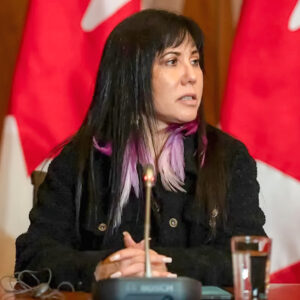
By Darryl R. J. Leroux, Associate Professor, Department of Social Justice and Community Studies, Saint Mary’s University
Recently in Canada and the United States, a small but vocal minority of white French-descendants have used an ancestor born between 300 and 400 years ago to claim an “Indigenous” identity. Most of these claims are to a “Metis” identity, though many also claim “Abenaki” and “Algonquin” identities.
Since 2014, I’ve been researching this shift into an “Indigenous” identity, which has been especially noticeable since a series of Supreme Court of Canada decisions between 1999 and 2003.
For my book, Distorted Descent: White Claims to Indigenous Identity, I dove into 12 years of online genealogy forums. One of the most surprising findings was how the same French women were transformed into Indigenous women on different forums in both French and English.
Building on the work of academics Kim TallBear and Alondra Nelson, this practice is called aspirational descent. It involves changing an ancestor’s identity to fit one’s current desire to shift away from a white identity.
Often, this is done by opponents of Indigenous land claims. In other cases, as in U.S. Senator Elizabeth Warren, one simply repeats false family stories passed down over the generations, ignoring the voices of Indigenous peoples along the way.
This practice isn’t only limited to online spaces. The same French women are also used by the three largest “Metis” organizations in Quebec and half a dozen “Abenaki” tribes in New England for membership. The practice is so common that in the 5,000 membership records that I’ve seen, about 30 per cent of members have no Indigenous ancestry at all: they rely solely on a French women born prior to 1650 for their so-called Indigenous identity.
After reviewing their records, it’s fair to say that about 50 “Indigenous” organizations created since 2003 are Indigenous only in name: no level of government, court or Indigenous Peoples have recognized them as Indigenous.
Using the example of two women who come up repeatedly online and in organizational records, I will explain how this works.
Catherine Lejeune: An Acadian woman turned ‘Mi’kmaq’
Catherine Lejeune was born in France around 1633. For almost a century, researchers speculated that Lejeune had been Mi’kmaq. This theory, based on a French historian’s faulty argument in the 1880s, led to a number of fanciful stories about her origins among genealogists. The most common, which continues to circulate widely today, claims that Lejeune is the granddaughter of Mi’kmaw Grand Chief Henri Membertou. There’s no evidence to support this claim.
Over the past 20 years, a number of historians of early Acadia have provided compelling documentary evidence that she was born in France. Plus, the results of genetic ancestry testing of nearly a dozen of her present-day descendants have consistently pointed to her French origins. There’s no longer a debate about Lejeune’s origins among historians.
Despite the academic consensus, Lejeune continues to be identified as Indigenous online and among several self-identified Indigenous organizations. For instance, nearly a hundred members of the Communaute Metis autochtone de Maniwaki and the Communaute Metisse du Domaine-du-roi et de la Seigneurie de Mingan count Lejeune as their sole “Indigenous” root ancestor.
Both organizations have recently been involved in protracted legal proceedings claiming Aboriginal rights for their allegedly Metis membership. Since 2014, nearly 100 individual members have lost nearly 60 separate court cases, yet they continue to press on in the courts.
The Alliance autochtone du Quebec (AAQ), another organization representing the so-called Quebec Metis, also accepts Lejeune as an Indigenous root ancestor. In a 2016 court case, two AAQ members from Rouyn-Noranda claimed Aboriginal rights with Lejeune as the basis for their Indigenous identity. They lost the case, but the judge ultimately didn’t comment on their claim that Lejeune was Mi’kmaq.
Catherine Pillard: A fille du roi turned ‘Algonquin-Siberian’
The most stunning display of aspirational descent is without a doubt that of Catherine Pillard. Once New France came under French Crown authority in 1663, King Louis XIV started paying for girls and young women to settle in the colony. Over a period of 11 years, the Crown sponsored about 800 filles du roi, pressing them into reproductive service.
Until 2007, there was little doubt that Pillard had been one of these young women. Historians long ago identified her baptismal certificate from La Rochelle, on France’s west coast. She was believed to have arrived with the first shipment of women in the spring of 1663. Two years later in October 1665, when Catherine was 19, she married Jean Charron, with whom she had 12 children.
But something strange happened in 2007 that would challenge generations of conventional wisdom. Three genealogists with ties to “Eastern Metis” organizations published a paper suggesting that Catherine had in fact been an Indigenous woman.
The paper was based on DNA ancestry tests of several of Pillard’s present-day descendants. The researchers had tested their mitochondrial DNA, which is passed down unchanged through ones’ maternal lineage. Isolating Pillard’s mtDNA, they identified it as part of a subgroup commonly associated with peoples Indigenous to the Americas.
Their argument lacked clarity about Pillard’s precise origins, but online forums blew up with speculation anyway. Before long, Pillard had been renamed Catherine “Ouenta,” the long-lost daughter of Huron-Wendat chief Atsena, on a wide range of online sites.
“Metis” organizations in Quebec and “Abenaki tribes” in Vermont and New Hampshire added hundreds, if not thousands of members who discovered Pillard in their genealogy. By the time I was researching my book in 2017, she had become one of the principal “Indigenous” ancestors used by French-descendants to become “Indigenous.”
Short-lived
Pillard’s time as an “Indigenous” woman was short lived. The family association representing tens of thousands of Pillard’s descendants hired a high-profile genetic genealogist to verify the study’s results.
Jacques Beaugrand, an independent scientist, retested the same mtDNA and came up with significantly different results. Instead of DNA associated with Indigenous peoples via eastern Siberia, he concluded that the mtDNA was associated with a region of western Asia. It turns out that Catherine Pillard had inherited mtDNA from a women who had travelled to Western Europe via present-day Armenia or Kazakhstan centuries before.
After archival research by two historians further confirmed the documentary record supporting Pillard’s French identity, the family association closed its case. Pillard returned to her original identity as a French woman.
At least, she did for those dedicated to the available evidence. For those involved in the “Eastern Metis” movement, Pillard has remained the daughter of a well-known Huron-Wendat chief.
The trouble with self-identification
Over the past 15 years, dozens of defendants in court have used either Lejeune or Pillard to claim Aboriginal rights. All have lost.
Countless others are using French women ancestors to become “Indigenous” to apply for jobs, scholarships and bursaries, advisory roles and other opportunities reserved for Indigenous people. Even some reputable Indigenous organizations are now led by white French-descendants taking advantage of mainstream confusion about Indigenous identity to identify as “Quebec Metis” or “Acadian-Metis.”
A recent CBC Indigenous report identified at least one sitting MP and several federal candidates claiming a similarly questionable Indigenous identity.
This will continue, as long as we continue to ignore the voices of Indigenous Peoples and use self-identification as the sole basis for Indigenous identity claims.
___
This article is republished from The Conversation under a Creative Commons license.







Hello. You seem to like writing and investigation. The sixties had children taken and they have a physical build and look that is often discriminated and vocally insulted in their face by both native and non native. We , meaning myself, get mistreatment daily. I’m from the sixties and still getting this regularly without any help from either side. DNA only tested 19% but if all were tested then what would I test and futhermore that DNA might trace back to significant elders of great reputation.
There is an election coming up and the free trade deal is not spoken about. This deal could contain words about prostitution, age of consent, native DNA, automated borders for products, driverless automated trucks traffic. We don’t know but we will vote and the politician will claim it mandated through the electoral process.
If my mother was to gain back her full status then what percentage of DNA of a full native do I have.
A taken person that looks like you without any status.